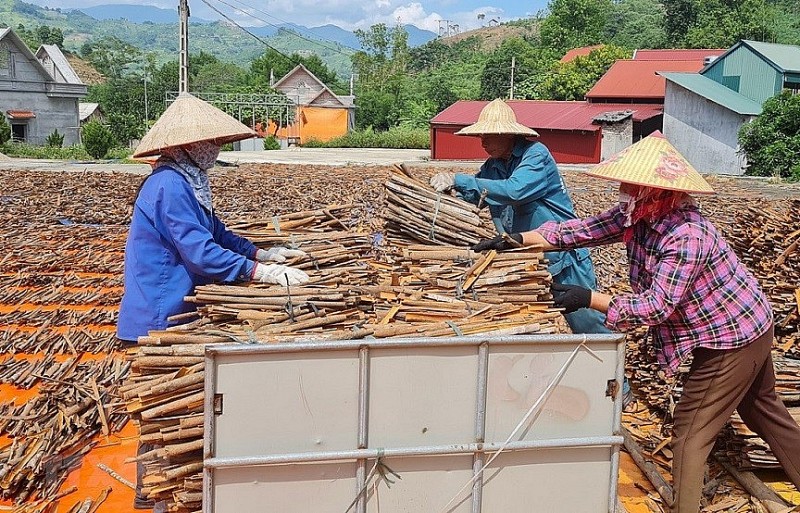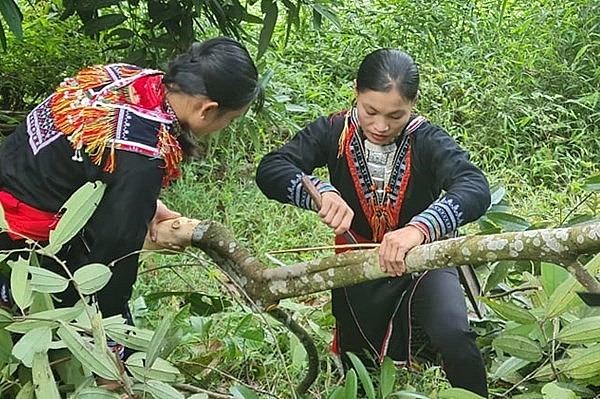
In search for cinnamon plantation sustainability in Lao Cai province
Latest
In a short time, the inhabitants in Nam Tha commune, Van Ban district (Lao Cai) have developed more than 600 hectares of cinnamon plantation. Last year, in this commune, there were 9 cases of planting cinnamon on natural forest land, which were documented in criminal proceedings with 46 households under administrative sanction. An apparent question is raised, whether Lao Cai has been hectically "hot" in growing cinnamon for economic development?
 |
| Cinnamon bark from Nam Det is under the offtake agreement with “Chien Thang” Organic Cinnamon Cooperative for procurement and export to India, some Middle Eastern countries and fastidious markets such as European Union and Japan. (Photo: VNA) |
Concern in quality control
First of all, we take it for granted that cinnamon is the staple tree contributing to poverty reduction for the people in Lao Cai, especially among the ethnic minority and in the mountainous areas.
Driven by its high value, the area of cinnamon growing in the locality has been expanded. According to Lao Cai Department of Agriculture and Rural Development, in 2010 the area of cinnamon growing in the province was about 4,000 hectares, in the period 2015-2020 the province sets a target of 20,000 hectares of cinnamon. However, by 2020, 42,000 hectares have been turned into cinnamon plantation, including 3,500 hectares of organic cinnamon.
In the agricultural development strategy of Lao Cai province and Resolution no.10 of the Lao Cai Provincial Party Committee, cinnamon is also identified as one of the key commodities of the province in the 2021-2030 period.
Therefore, to develop cinnamon trees, Lao Cai has issued a policy to support the designation of organic cinnamon certificate in the province in the period of 2021-2025; creating favorable conditions on land clearance for businesses when investing in processing the cinnamon products.
However, it is worth mentioning that a few years ago, when the price of fresh bud tea was unstable, many households in Lao Cai planted cinnamon in their tea fields. The authority of Nam Tha commune revealed “the people keep planting, and our governance could not cover all frequently, because they live in deep forest and core areas. The people kept low key slash-and-burn clearing the land, by the time we detected it, their plantation had already been formed.”
The other aspect was commented by the experts: “The cinnamon cultivation on tea fields needs to be reconsidered, because cinnamon is an essential oil plant. Besides, with the current too thick density, the output of tea as well as the yield of cinnamon could not be guaranteed.
The rapid increase in production, while the traditional market share is approaching the threshold point, are also the factors hindering the development of cinnamon in Lao Cai.
Upholding the value chain to access export markets
Currently, Lao Cai has been directly exporting cinnamon products to 9 markets including: Singapore, India, Thailand, Malaysia, Bangladesh, Qatar, Lebanon, Israel, and Turkey. However, it is still mainly cinnamon bark products and low-value essential oils, very few essential oils are exported to high-end markets such as the EU and the US.
According to the assessment of Lao Cai Department of Agriculture and Rural Development, although the province has had many mechanisms and policies to encourage investment and development of cinnamon trees, the locality still faces many difficulties.
It refers to the low quality of the seed source; the genetic quality has been improved to a low degree. There is no seed nursery plantation; the production techniques for seedlings mainly rely on the local people using their indigenous knowledge and long-term experience. There is no official nursery technique. The standard area of organic cinnamon plantation accounts for low rate.
Besides, the consumption of products (bark, leaves) depends entirely on traders. People often plant trees in manner of herd behavior, which leads to no promotion of collective strength, and is pinched by traders on prices.
In addition, enterprises operating in the production, processing and trading of cinnamon products have not yet coordinated or closely linked with the people, while the cinnamon forest does not have a certificate of sustainable forest management.
It is well worth mentioning, for cinnamon and cinnamon products, that the concept of organic has not been perceived. Tertiary processing is just the production of essential oils. In addition, the segments related to logistics and product promotion still face many snags affecting the development of the industry.
 |
| Ethnic minority people in Lao Cai peeling off the cinnamon bark in harvest season. (Photo: Infonet) |
In order for the cinnamon industry to develop sustainably, it is said that Lao Cai needs to identify the product market and produce according to the demands of the market; appropriate mechanisms and policies and effective communication to change people's perceptions.
At the same time, enterprises are encouraged to participate in the cinnamon industry, because it would be bridging the cooperatives and the export market. It is encouraged to establish collective production groups and cooperatives to promote linkages among farmers' households to create raw material areas and create linkages with businesses for consumption.
It is reported that Lao Cai province is focusing on promoting research on market development trends and demands of consumption of post-processed cinnamon products in the context of production promotion and export to fastidious markets, focusing on the markets in the U.S and Europe.
| From now up to 2025, Lao Cai province maintains the operation of existing processing facilities, and at the same time focuses on making investments in the construction of a cinnamon essential oil extraction facility, specifically: it is to build one refinery processing plant for cinnamon oil with a capacity of over 500 tons of essential oil/year; 2 factories for tertiary processing of cinnamon bark, with a capacity of over 10,000 tons. In the period 2026-2030, continue to increase the processing capacity of cinnamon processing facilities in the area. |

























